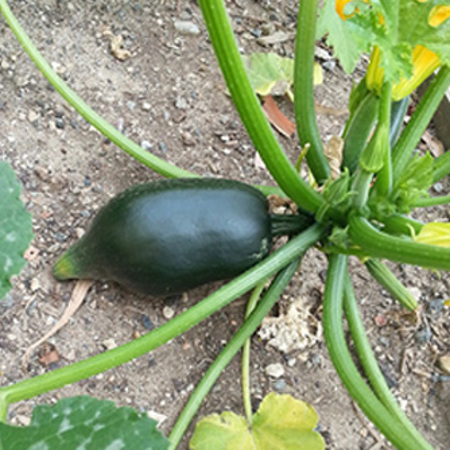Zucchini
BackZucchini is a popular and easy to grow vegetable that is a fast growing crop for the warmer months of the year. Also known as courgettes or summer squash, there are more varieties than just the dark green type we find in the supermarket. There area also golden, mottled green, and striped varieties including Golden Arch Crookneck, Golden straight neck, Italian light green and Costata.
Ever tried eating a zucchini flower? Yes that’s right the flowers can be eaten raw, stuffed or lightly fried in batter. You’ll find they are quite the rage in trendy restaurants these days!
How to Grow Zucchinis
Zucchinis are large, sprawling plants so be sure to give them ample room to grow and spread out, at least 70cm of spacing between each plant.
Choose a full sun position and free draining soil that’s been enriched with compost or well-rotted animal manure. Seeds take around 10 days to germinate and can be sown directly into the garden or into punnets and planted out later. Apply OCP eco-seaweed to get seeds and plants off to a good start.
Please note that zucchinis are frost sensitive and seeds require a warm soil to germinate. So if you are sowing early in a cool climate you may need to place them on a heating tray or in a warm posy.
Mulching is essential to maintain soil moisture and prevent weeds from germinating. Keep your plants well watered especially during dry spells and high temperature days.
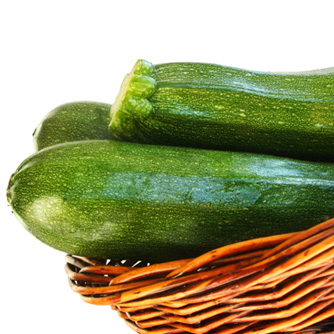
Zucchini freshly harvested
Sowing Guide
| Growing Zone | Sowing Time |
| Cool Zones | Spring, Summer |
| Mediterranean Zones | Spring, Summer |
| Warm & Temperate Frost Free Zones | Spring, Summer, Autumn |
| Tropical & Subtropical Zones | Spring, Summer, Autumn, Winter |
Fertilising
If you haven’t already worked in some compost or aged animal manure, as mentioned above, now is the time to go do it! To ensure a good supply of calcium, apply lime or dolomite at the time of planting and once again halfway through the growing season.
Zucchini plants grow fast and produce lots of fruit. To support them liquid feed with a mixture of OCP eco-aminogro and OCP eco-seaweed every 2-4 weeks.
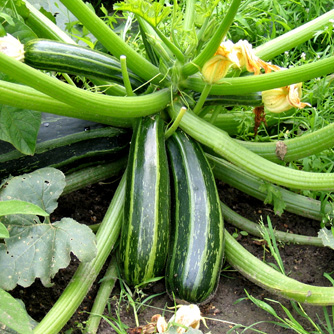
Cocozelle zucchini with light green stripes
Harvesting
Zucchini will be ready to harvest anywhere from 6-8 weeks after planting. For optimum flavour they are best picked around 15cm in length using a sharp knife or secateurs. The fruit grows very fast so check your plants frequently. If you leave them longer they become huge and turn into marrows which are tougher to eat and taste bland.
Flowers can be harvested in the morning when they are at their freshest. You can even harvest tiny zucchinis with the flowers still attached!
Pest and Diseases of Zucchini
Things to look out for are :
- Greenhouse whitefly are a common problem in the veggie patch but are easily treated with OCP eco-oil. Be sure to spray at the first sign of trouble to control numbers.
- Aphids and mites - these sap suckers are also common but can be controlled by spraying with a horticultural oil.
- Look out for the bad leaf-eating ladybeetle which love zucchini leaves. The adult beetles are yellowy-orange with 26 or 28 spots and are usually found munching on the topside of leaves. The larvae feed on the underside and are a greeny yellow colour with long black spines. Don’t confuse them with good ladybeetles that have fewer spots and feed on pests like aphids. If you’re unsure watch them for a few minutes. If they are feeding on the foliage then pick them off by hand.
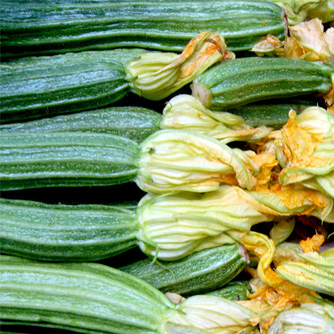
The Costata zucchini is also striped but with raised ridges
- Powdery mildew is a very common fungal disease that quickly spreads across foliage particularly in the second half of the season. Watch out for it and spray early with OCP eco-fungicide to keep it under control. You’ll most likely see yellow and black lady beetles on the leaves and they are feeding on the powdery mildew. While this is a good thing the mildew spreads faster than they can eat so spraying is still needed for control.
- Blossom end rot causes fruit to rot at the end and drop off before it ripens and is due to infrequent watering and/or a lack of calcium. Give plants deep and regular waterings and apply a high calcium product (eg lime, dolomite or gypsum) throughout the growing season.
- Zucchini plants are susceptible to several mosaic viruses which are spread by aphids. Infected plants develop distorted and twisted foliage and fruit production declines. Fruit itself is often distorted and stunted. Mottling of foliage and fruit may also occur. There is no cure and infected plants must be destroyed. It highlights the importance of controlling aphids to prevent the virus spreading.
- Root-knot nematodes cause distorted, lumpy roots below ground and weak growth above ground. Apply OCP eco-nemguard at planting time to protect newly developing roots. Reapply every 4-6 weeks for continued protection. Boosting the level of organic matter in soils (with compost and manures) and using crop rotation can also help suppress nematode numbers.
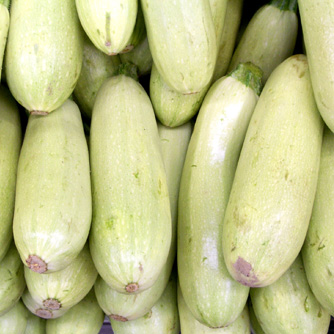
The Grey zucchini variety are extremely pale in colour
Other Problems
Distorted fruit – a surge of excess water (from rain or by an over zealous gardener) can cause the fruit to grow unevenly. Stick to regular consistent watering. Only suspect a viral problem if the foliage is also distorted.
Too many male flowers – yes zucchinis produce separate male and female flowers. The stem of male flowers is long and skinny (like a pencil) while the stem on female flowers is short, fat and already starting to look like a zucchini. It is not unusual for plants to produce a string of male flowers especially at the start of flowering. Just be patient. Female flowers will develop.
Fruit not developing at all – most likely it’s because all the flowers are male. Just wait it out and the plant will produce some female flowers (see directly above). If you definitely have female flowers then it could be a lack of pollination. Usually though fruit partially forms before withering when there is a lack of pollination.
Fruit partially developing before rotting or withering – fruit may fail due to blossom end rot (as already mentioned) or a lack of pollination. Bees and other insects normally pollinate zucchinis but if you don’t have enough of these helpful guys about we recommend planting flowering plants within the veggie patch to help attract them. You can also hand pollinate by transferring pollen from male flowers to the female flowers.
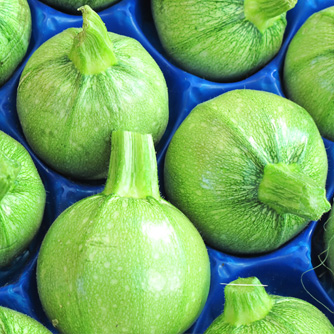
Ronde de Nice zucchini are pale green and round in shape



